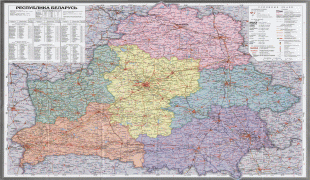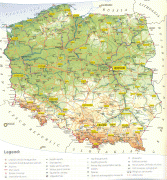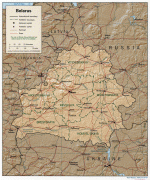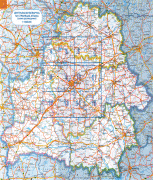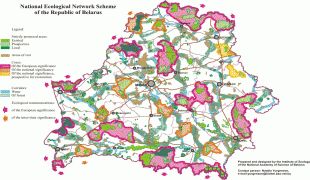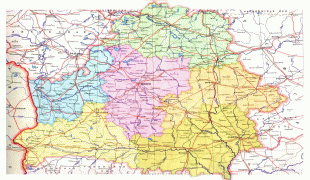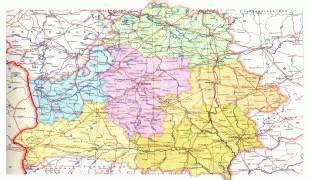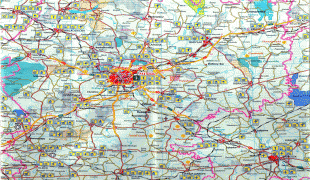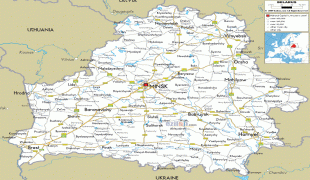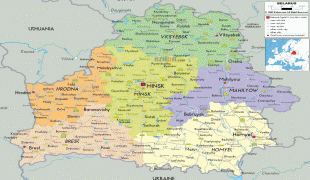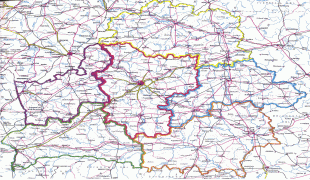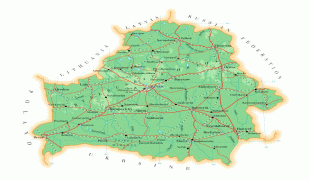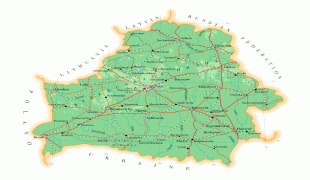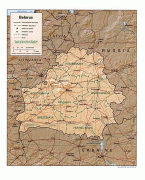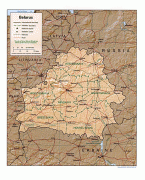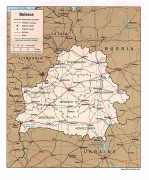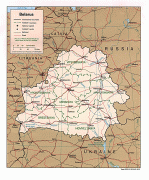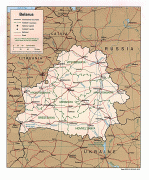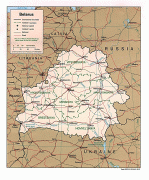Belarus (Republic of Belarus)
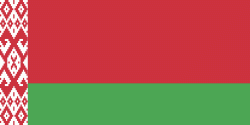 |
 |
| Flag of Belarus | |
Until the 20th century, different states at various times controlled the lands of modern-day Belarus, including Kievan Rus', the Principality of Polotsk, the Grand Duchy of Lithuania, the Polish–Lithuanian Commonwealth, and the Russian Empire. In the aftermath of the Russian Revolution in 1917, different states arose competing for legitimacy amid the Civil War, ultimately ending in the rise of the Byelorussian SSR, which became a founding constituent republic of the Soviet Union in 1922. After the Polish-Soviet War, Belarus lost almost half of its territory to Poland. Much of the borders of Belarus took their modern shape in 1939, when some lands of the Second Polish Republic were reintegrated into it after the Soviet invasion of Poland, and were finalized after World War II. During World War II, military operations devastated Belarus, which lost about a quarter of its population and half of its economic resources. The republic was redeveloped in the post-war years. In 1945, the Byelorussian SSR became a founding member of the United Nations, along with the Soviet Union.
The parliament of the republic proclaimed the sovereignty of Belarus on 27 July 1990, and during the dissolution of the Soviet Union, Belarus declared independence on 25 August 1991. Following the adoption of a new constitution in 1994, Alexander Lukashenko was elected Belarus's first president in the country's first and only free election post-independence, serving as president ever since. Lukashenko heads a highly centralized authoritarian government. Belarus ranks low in international measurements of freedom of the press and civil liberties. It has continued a number of Soviet-era policies, such as state ownership of large sections of the economy. Belarus is the only European country using capital punishment. In 2000, Belarus and Russia signed a treaty for greater cooperation, forming the Union State.
Belarus is a developing country, ranking 60th on the Human Development Index. The country has been a member of the United Nations since its founding and has joined the CIS, the CSTO, the EAEU, the OSCE, and the Non-Aligned Movement. It has shown no aspirations of joining the European Union but nevertheless maintains a bilateral relationship with the bloc and also participates in two EU projects, the Baku Initiative and the Eastern Partnership. Belarus suspended its participation in the latter on 28 June 2021, after the EU imposed more sanctions against the country.
The name Belarus is closely related with the term Belaya Rus, i.e., White Rus. There are several claims to the origin of the name White Rus ' . An ethno-religious theory suggests that the name used to describe the part of old Ruthenian lands within the Grand Duchy of Lithuania that had been populated mostly by Slavs who had been Christianized early, as opposed to Black Ruthenia, which was predominantly inhabited by pagan Balts. An alternative explanation for the name comments on the white clothing worn by the local Slavic population. A third theory suggests that the old Rus' lands that were not conquered by the Tatars (i.e., Polotsk, Vitebsk and Mogilev) had been referred to as White Rus'. A fourth theory suggests that the color white was associated with the west, and Belarus was the western part of Rus in the 9th to 13th centuries.
The name Rus is often conflated with its Latin forms Russia and Ruthenia, thus Belarus is often referred to as White Russia or White Ruthenia. The name first appeared in German and Latin medieval literature; the chronicles of Jan of Czarnków mention the imprisonment of Lithuanian grand duke Jogaila and his mother at "Albae Russiae, Poloczk dicto" in 1381. The first known use of White Russia to refer to Belarus was in the late-16th century by Englishman Sir Jerome Horsey, who was known for his close contacts with the Russian royal court. During the 17th century, the Russian tsars used White Rus to describe the lands added from the Grand Duchy of Lithuania.
The term Belorussia (Белору́ссия, the latter part similar but spelled and stressed differently from Росси́я, Russia) first rose in the days of the Russian Empire, and the Russian Tsar was usually styled "the Tsar of All the Russias", as Russia or the Russian Empire was formed by three parts of Russia—the Great, Little, and White. This asserted that the territories are all Russian and all the peoples are also Russian; in the case of the Belarusians, they were variants of the Russian people.
After the Bolshevik Revolution in 1917, the term White Russia caused some confusion, as it was also the name of the military force that opposed the red Bolsheviks. During the period of the Byelorussian SSR, the term Byelorussia was embraced as part of a national consciousness. In western Belarus under Polish control, Byelorussia became commonly used in the regions of Białystok and Grodno during the interwar period.
The term Byelorussia (its names in other languages such as English being based on the Russian form) was only used officially until 1991. Officially, the full name of the country is Republic of Belarus (Рэспубліка Беларусь, Республика Беларусь, Respublika Belarus ). In Russia, the usage of Belorussia is still very common.
In Lithuanian, besides Baltarusija (White Russia), Belarus is also called Gudija. The etymology of the word Gudija is not clear. By one hypothesis the word derives from the Old Prussian name Gudwa, which, in turn, is related to the form Żudwa, which is a distorted version of ''Sudwa, Sudovia. Sudovia'', in its turn, is one of the names of the Yotvingians. Another hypothesis connects the word with the Gothic Kingdom that occupied parts of the territory of modern Belarus and Ukraine in the 4th and 5th centuries. The self-naming of Goths was Gutans and Gytos, which are close to Gudija. Yet another hypothesis is based on the idea that Gudija in Lithuanian means "the other" and may have been used historically by Lithuanians to refer to any people who did not speak Lithuanian.
Currency / Language
| ISO | Currency | Symbol | Significant figures |
|---|---|---|---|
| BYN | Belarusian ruble | Br | 2 |
| ISO | Language |
|---|---|
| BE | Belarusian language |
| RU | Russian language |






